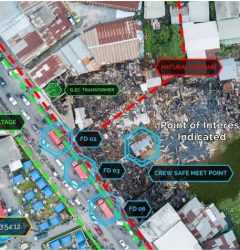- Mojo Vision, a startup in Saratoga, California, has developed a contact lens with augmented reality capabilities.
- The company claims that the lenses have a 14,000 ppi display.
- Even if the tech is sound, will people actually want these lenses?
Smart contact lenses—essentially flexible displays packed with augmented reality tech—are sci-fi fodder as ubiquitous as the flying car. And like the flying car, the idea of AR-powered supervision is always on the cusp of going mainstream.
Mojo Vision, a startup out of Saratoga, California, is the latest company that thinks it’s figured out what companies like Google, Sony, and Magic Leap haven’t. The company calls its breakthrough Mojo Lens.

Mojo Vision has a pretty lofty idea of what it wants to accomplish through its AR smart contacts. The Mojo Lens prototype can supposedly provide real-time contrast and lighting enhancements as well as zoom, like on a smartphone camera, that will help people struggling with low vision, a gradual loss of sight that cannot be reversed.
According to a press release that the company put out this week, the underlying concept is something called “invisible computing,” which Mojo says is a platform for instantaneous, hands-free info that will “allow people to interact with each other more freely and genuinely.”
Apart from providing a potential evolution for vision prostheses, Mojo says its contact lenses will help industrial workers access real-time information, which can increase productivity or compliance far better than a vision-blocking headset. Mojo Lens would also be an asset for emergency responders, like firefighter shields that can display information about temperatures or what parts of a building are behind curtains of flames.
Fast Company describes one Mojo Lens mockup as allowing a firefighter to see “situational things while they’re holding an axe or a hose or some other piece of equipment, and they don’t have time to pull out their phone.”
Mojo Vision says it has created the “smallest and densest dynamic display ever made,” which includes a 14,000 pixel-per-inch display with eye-tracking, image stabilization, and a custom wireless radio. The display needs all those pixels because it’s directly laid onto your eyeball.
A current prototype—shown off at the Consumer Electronics Show in Las Vegas earlier this month—includes a display right at the center of the lens, positioned directly before the pupil. The screen is so tiny that the eye can barely see it. Most of its light is focused on a small portion of the retina at the back of the eye, called the fovea.
This small depression is where our eyesight is sharpest, so it helps to define details of the objects right in front of us. The fovea takes up just about four to five percent of the retina’s overall area, but contains most of its nerve endings. So, it makes sense that Mojo wants to shoot a display directly into this portion of the retina. The high number of photoreceptors means the lenses require less power and less light to transmit images.



